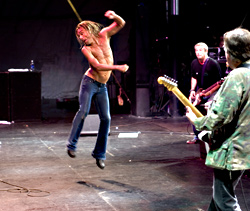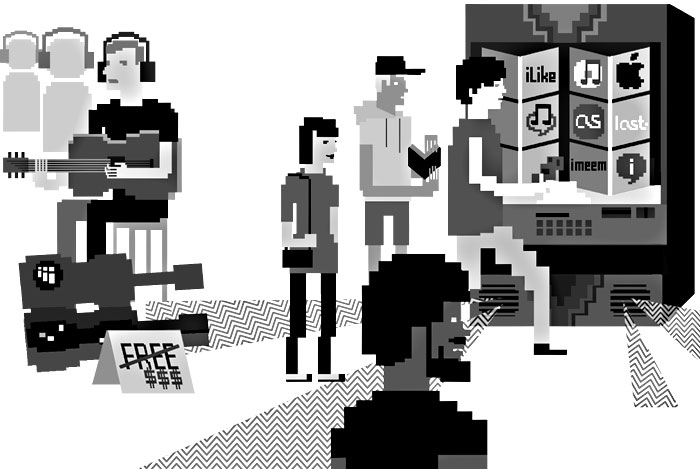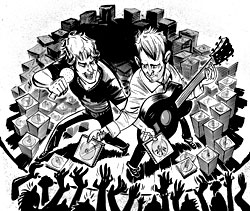Ron Asheton will tell you he hasn’t changed much since writing classic albums like Fun House and spending three years playing guitar while Iggy Pop bounced around stage before embarking on a solo career. He’ll say that his songwriting and the fundamental components of his dream job are relatively the same now that the Stooges have reunited, but as he’s scrambling to get ready for his first such touring gig in more than 30 years, it’s obvious that the man who riffed on “I Wanna Be Your Dog” actually has changed a touch.
“You can’t believe all of the stupid things in your personal life that you have to do if you’re going to be gone for this long: buy tons of kitty litter, tons of cat food, bills, get everyone prepared, tons of notes. ‘Don’t forget to change the water for the cats in the little bathroom—that’s Harriet’s favorite place to drink!’ Each kitty’s got their own favorite set of things,” says the man Rolling Stone named one of the Greatest Guitarists of All Time.
Asheton’s work on albums like The Stooges and Fun House earned him that honor; today, they’re considered some of the great proto-punk classics, responsible for spawning every angry, guitar-based genre from garage punk to metal. The albums sold poorly at the time. Compared to the softer psychedelic music of the era, the Stooges were too dynamic, sexy, thrashing and raw. Their albums, including anthems like “I Wanna Be Your Dog” and “Down on the Street,” were nihilistic and sleazy, raunchy and bluesy—simply ahead of their time.
The Stooges dissolved after Iggy, the boss, introduced other plans, including a drug addiction and solo aspirations. Since then, more than three decades have passed; Asheton has been working odd jobs, including a guest appearance on Velvet Goldmine. His brother Scott has played drums in a succession of short-lived bands. Iggy Pop turned 60 on Saturday.
Though Scott Asheton had long championed a Stooges reunion, Pop said no. But working with his old bandmates on a collaboration? That was different. “Iggy called me up and asked if I’d be interested in a project, me and my brother. That was what really got us going, which was only two songs for the CD [Skull Ring] and wound up being four. He said, ‘My management [has] been getting calls, and would you be interested in doing a show?’ We did the show—it wound up being Coachella [in 2003]….After the show, he came up towards our trailer, and he said, ‘Would you be available for more shows this year?’ And I thought, yes!”
2007’s The Weirdness, the Stooges’ first studio album in 35 years, was three years in the making. That alone gives this second Stooges incarnation a life span as long as that of the original Stooges. During that time, Asheton and company wrote 42 songs to come up with the album’s final 12 tracks.
As far as the approach to songwriting goes, says Asheton, “Nothing’s changed. Only that it comes out easier. I don’t struggle. I never really struggle struggled, but now stuff just pours off the top of my head….This new record was the most fun because it was the most well-paced.” But well-paced isn’t necessarily conducive to the maniacal, balls-out frenzy that marked the Stooges’ trademark sound. And even though he’s doing the same job as before, Asheton’s not the same guitarist as the man who wrote those albums. For one, he’s 58 and currently has three cats. And although the music he now likes is the same as what he liked back in the Stooges’ heyday (“Today, 90 percent of it’s crap,” he grumbles), that relative lack of experimentation may have helped to flatten the somewhat lackluster sound that marks The Weirdness: think less hunger and crazy sex; fewer tiger bites, more cats.
While they’d been in touch with Jack White, the White Stripes’ frontman had too much on his plate when the Stooges wanted to record. Their next choice for a producer, Steve Albini, best known for his work with the Pixies, takes a notoriously minimalist approach. Everything was recorded live, leaving little to change or challenge their sound.
Despite the mixed reviews for the album (Pitchfork claimed it “hideously disgraces the band’s original work”), Asheton is fine with it. “That’s OK—you can’t please everyone. Now, people are going, Fun House is the classic-rock album. But when Fun House came out, everyone hated it. I don’t take it to heart if someone doesn’t like it.”
Asheton’s day at the office doesn’t end in the studio, and reviews of the Stooges’ live show have thus far been messianic.
“There are people who never thought they’d see the Stooges,” beams Asheton, who is surely one of them. Iggy Pop’s onstage antics and sheer brilliant lunacy are intact, and no one else has to be acrobatic, or even mobile, to make that work. “I always say I’ve got the easy job….I stand in one position, I hide behind a piece of wood. I stand by the monitors, so I’ve got the whole band right in my little area. I’m out of harm’s way most of the time from Iggy—he has hit me a few times with mike stands when I wasn’t looking. Luckily, I wasn’t terribly injured.”
Thus far, the Stooges’ second incarnation is on its way to outlasting the first. Their next step, a much-needed challenge, may be right on the horizon: “Iggy’s already talking about doing another record at the end of 2008. This time, we’ll do something different. This time, we’ll get Jack [White] to do it.”








